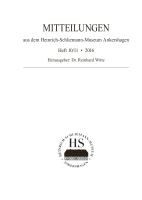
120
aid of short quotations I will describe Schliemann’s journey, and finally I will brief-
ly examine the possibilities that Schliemann’s diaries offer for further research.
Schliemann’s archive at the Gennadius Library
The diary is part of a huge archive that is kept in the Gennadius Library in Ath-
ens. When studying the documents of Schliemann’s archive (or any archive), one
should bear in mind the following three questions:
1. Is the document digitally available? If not, you will have to study the original
yourself in Athens or have it examined by others. All Schliemann’s diaries are
now digitally available, but many other documents are not.
2. Can we read Schliemann’s handwriting? In general I found his handwriting
clearly legible but there are some examples which are difficult to decipher.
4
3. Can we read the language in which the document to be studied is written?
Documents can have been written in many different languages. Apart from
the A3 diary, the diaries from for example 1864 and 1866 have also been writ-
ten in six different languages. Once in a while a diary is written in only one
language: the 1859 diary is completely in Spanish.
The Schliemann archive in Athens has been subdivided into different sections/
series, for example
5
:
- Series A: Diaries (all 18 have been digitized). So the A3 diary stands for section
A, diary number three;
- Series B: Correspondence (34,000 letters received by Schliemann);
- Series BB: Original letters (written by Schliemann);
- Series BBB: Copybooks of Letters (43 volumes, only 15 of which digitized);
- Series C: Manuscripts and other handwritten notes;
- Series D: Personal Documents;
- Series E: Economics (30 account books, 5 cashbooks and 4 books of expenses);
- ...
During his travels, Schliemann kept a diary or travelogue. Copies of his letters
were made in a copybook (Series BBB) and his expenses were kept in account
books (Series E). During his travels the diary, copybook and cashbook can be
seen as an ensemble: they were created within the same timespan and within the
ensemble they provide information about each other.
4
See for example theA1 diary from 1846. Here three pages (278-280) were written when Schliemann’s
ship was moving violently to and fro. But also the German texts in theA5 diary from 1864-65 are very
difficult to read.
5
For a complete overview:
www.ascsa.edu.gr/index.php/archives/heinrich-schliemann-finding-aid.








